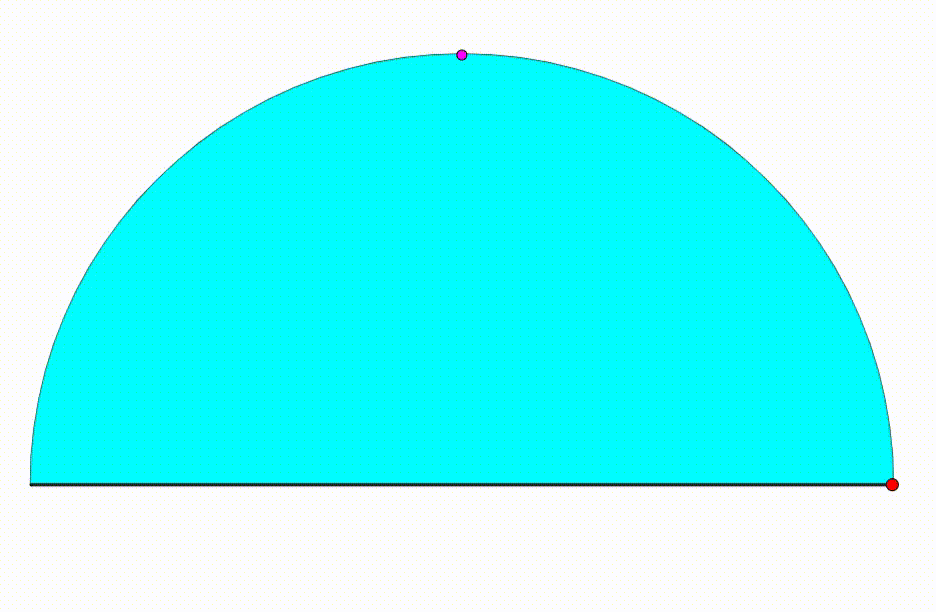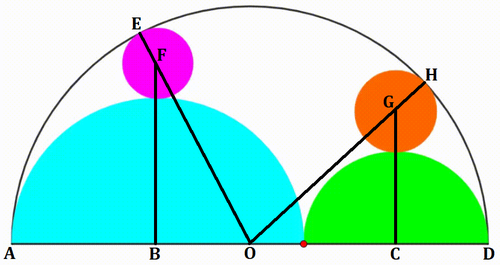Dynamic Geometry: P61
 The diagram shows a black semicircle. A red point is moving freely on its diameter, creating two semicircles, cyan and green. The purple and orange circles have the same
x
coordinate as the cyan and green circles respectively. The purple and orange circles are internally tangent to the black semicircle and tangent to the cyan and green circle respectively. When the ratio of the purple circle's radius to the radius of the orange circle is equal to
1
3
1
1
, the ratio of the cyan circle's radius to the radius of the green circle can be expressed as
q
p
, where
p
and
q
are coprime positive integers. Find
p
+
q
.
The diagram shows a black semicircle. A red point is moving freely on its diameter, creating two semicircles, cyan and green. The purple and orange circles have the same
x
coordinate as the cyan and green circles respectively. The purple and orange circles are internally tangent to the black semicircle and tangent to the cyan and green circle respectively. When the ratio of the purple circle's radius to the radius of the orange circle is equal to
1
3
1
1
, the ratio of the cyan circle's radius to the radius of the green circle can be expressed as
q
p
, where
p
and
q
are coprime positive integers. Find
p
+
q
.
The answer is 8.
This section requires Javascript.
You are seeing this because something didn't load right. We suggest you, (a) try
refreshing the page, (b) enabling javascript if it is disabled on your browser and,
finally, (c)
loading the
non-javascript version of this page
. We're sorry about the hassle.
2 solutions
Let the black semicircle have a radius of 1 , let the r p be the radius of the purple circle, r o be the radius of the orange circle, r c be the radius of the cyan semicircle, and r g be the radius of the green semicircle, and label the diagram as follows:

From segment A D , 2 r c + 2 r g = 2 , or r c + r g = 1 .
From the given ratio of the purple and orange circle radii, r o r p = 1 3 1 1 .
By the Pythagorean Theorem on △ O B F , ( 1 − r c ) 2 + ( r p + r c ) 2 = ( 1 − r p ) 2 .
And by the Pythagorean Theorem on △ O C G , ( 1 − r g ) 2 + ( r g + r o ) 2 = ( 1 − r o ) 2 .
These four equations can be solved to r c = 8 5 , r g = 8 3 , r p = 1 0 4 1 5 , and r o = 8 8 1 5 .
Therefore, the ratio of the cyan and green circle radii is r g r c = 8 3 8 5 = 3 5 , so p = 5 , q = 3 , and p + q = 8 .
Thank you for posting !
Let the center of the big semicircle be O , the radii or the cyan and green semicircle, purple and orange circles be r 0 , r 1 , r 2 , and r 3 respectively. Note that 2 r 0 + 2 r 1 = 2 ⟹ r 0 + r 1 = 1 .
By Pythagorean theorem , we have:
( r 0 + r 2 ) 2 + ( 1 − r 0 ) 2 r 0 2 + 2 r 0 r 2 + r 2 2 + 1 − 2 r 0 + r 0 2 2 r 0 2 + 2 r 0 r 2 − 2 r 0 ⟹ r 2 r 3 ∴ r 3 r 2 ⟹ 1 + r 1 r 1 ( 1 − r 1 ) 1 + r 0 r 0 ( 1 − r 0 ) 1 3 ⋅ 1 + r 0 r 0 ( 1 − r 0 ) 1 3 ⋅ 2 r 0 + r 1 r 0 r 1 2 r 0 + r 1 1 3 1 3 r 0 + 2 6 r 1 1 5 r 1 ⟹ r 1 r 0 = ( 1 − r 2 ) 2 = 1 − 2 r 2 + r 2 2 = − 2 r 2 = 1 + r 0 r 0 ( 1 − r 0 ) = 1 + r 1 r 1 ( 1 − r 1 ) = 1 3 1 1 = 1 3 1 1 = 1 1 ⋅ 1 + r 1 r 1 ( 1 − r 1 ) = 1 1 ⋅ r 0 + 2 r 1 r 1 r 0 = r 0 + 2 r 1 1 1 = 2 2 r 0 + 1 1 r 1 = 9 r 0 = 3 5 Similarly, Note that 1 = r 0 + r 1
Therefore p + q = 5 + 3 = 8 .